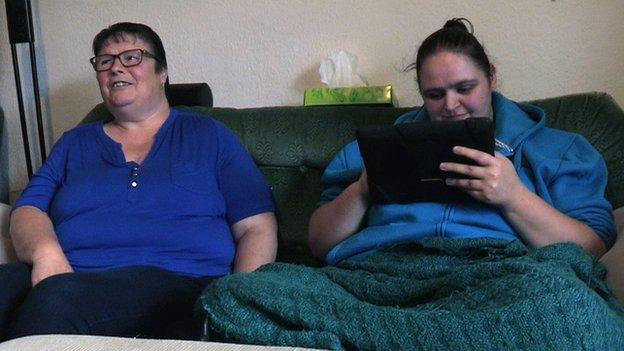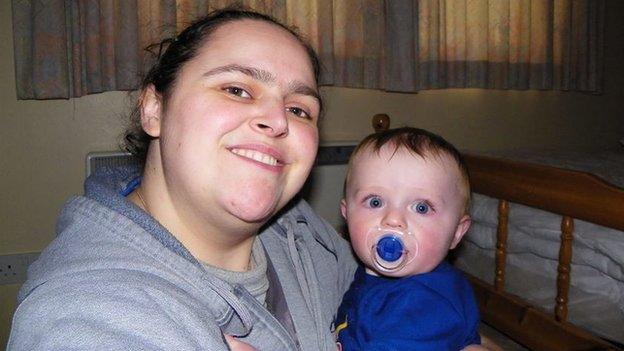Selective mutism: 'I have a phobia of talking'
- Published

Selective mutism - best described as a "phobia of talking" - is an anxiety disorder that affects thousands of children. But adults with the condition remain largely forgotten. What is it like for them?
"I could talk all my life to my nan, but when she had a stroke I was so anxious I stopped being able to speak to her."
Sabrina Branwood, from Rochdale, has had selective mutism since childhood - an anxiety disorder that prevents her from speaking in certain social situations and to certain people.
The condition - even in adulthood - meant she lost the ability to talk to one of her closest family members, something she greatly regrets.
Before her grandmother died, she was unable to tell her directly how she loved her.
Sabrina relies on her family and an app on her tablet to communicate.

Sabrina, right, uses an app on her tablet to communicate
The NHS defines selective mutism as something that affects children, but she is now aged 35.
"When people ask me questions, my anxiety makes it hard to think," she explains through her app. "Trapped. I'm not silent because I don't want to talk. I would rather talk freely but it's very difficult and complicated.
"Having selective mutism can feel like you're living your life in a box. The box is see-through so you can see out and hear people, but you can't leave no matter how hard you try.
"You can shout inside the box as loud as you like but nobody can hear you. They can't hear you cry when you're hurt or scared," she adds.

Selective mutism
Normally develops during early childhood, when children enter new social environments - such as nursery - away from immediate family.
It is more common in girls and those of ethnic minority populations.
Those with the condition are "literally unable to speak", rather than voluntarily refusing to do so.
Signs in children include nervousness, stubborn or aggressive behaviour when returning home following school and becoming frozen when unable to talk.
If left untreated, it can continue into adulthood.
The most effective forms of treatment are behavioural therapy and cognitive behavioural therapy.
Source: NHS

Communicating can be especially difficult for Sabrina when people are impatient and lack understanding, often seeing her as stubborn or rude.
But even speaking to her parents and siblings can become difficult when she is worried or upset. On some occasions, when she feels pressured by strangers, she suffers from panic attacks.
Sabrina explains how her fear of speaking has affected her life
It has led her to feel like she is losing out.
"I've missed out on so much I wanted to do, like having lots of friends and going lots of places without needing my family to take me."
Her selective mutism has become more difficult to manage over time.
"When you're a child your parents can do lots more to help, and speak for you, but as an adult you're meant to do all that stuff yourself and people expect you to be able to, but I can't."
Current estimates suggest one in 150 children in the UK have selective mutism. This falls to one in 1,000 with adolescents and one in 2,400 young adults. But the proportion of older adults with the condition is unknown.
Alison Wintgens, national adviser for selective mutism at the Royal College of Speech and Language Therapists, says care for adults with the condition is "extremely under-researched, with a real deficiency of services because it so often falls under the radar".
She describes selective mutism, in its simplest terms, as a "phobia of talking".
It is arguably most associated in popular culture with the character of Raj Koothrappali in the US sitcom The Big Bang Theory, who was originally unable to speak to women outside his family.

Kunal Nayyar's character Raj Koothrappali in The Big Bang Theory initially had selective mutism
Wintgens explains that the condition normally stems from childhood: "Something triggers it, a pretty everyday event - normally around the age of two or three - and it becomes a learnt and reinforced pattern."
This often includes freezing in uncomfortable situations, like a "rabbit in the headlights". Avoidance is another tactic employed by those with the condition.
"It is recognised more nowadays, but there is still a lot of ignorance. School staff and parents want to do best, but inadvertently can make the situation worse," Wintgens adds.
Sabrina says she did not get any support at school.
"The special educational needs teacher who wanted to assess me told me it was all in my head and sent me away. The school just ignored the problem then."
Her mother Dianne says the condition was hard to notice at home, as Sabrina communicated fully with family.
"She used to play with her brothers and sisters and talk to me and her dad. It was just outside of the family we thought she was very shy.
"It makes me feel as though I failed as a mum... because I didn't spot the signs. But I had never heard of the condition."

Sabrina Branwood holds her nephew Theo
Misinterpreting selective mutism as shyness is a common mistake, according to Wintgens, but psychologically the difference between the two can be pronounced.
She explains that shy people are generally "slow to warm up", but are eventually likely to take part in conversations and situations.
But people with selective mutism "have a consistent and predictable pattern, finding it impossible to talk to the same people and in the same places".
If untreated, according to Carl Sutton, founder of the support group iSpeak, "other anxiety disorders - such as agoraphobia - are very likely outcomes for adults."
Depression, he adds, is almost universal, and while young adults do manage to circumvent their difficulties, many others are virtually housebound.
Until 2011, Sabrina had been receiving treatment from a psychologist for three years after being referred by her GP. But after her case was reassessed by the service provider, she was discharged and says all subsequent referrals have been refused.
The only care she has since been offered was short-term therapy.
Her mother says the prospect of Sabrina getting a job is currently "off the table", even despite Sabrina retaining independence by living in her own home.
"She has done voluntary work for [the charity] Mind but it's been hard for her to enter into those jobs. Once she gets into them, she enjoys them.
"It was difficult, but she got close to people. She used to text a lot and would send emails [to colleagues]."
Sutton's research - which looked at 83 people who have, or have had, selective mutism in adulthood - suggests the average "turning point" on the way to overcoming the condition takes place aged 22.
But although Sabrina is past this age, she still holds hope of recovering.
"I want to work with other sufferers," she explains. She is currently studying for a degree in psychology with the Open University.
Victoria Derbyshire broadcasts weekdays from 09:15-11:00 BST on BBC Two and the BBC News Channel.
Subscribe to the BBC News Magazine's email newsletter to get articles sent to your inbox.
- Published17 August 2012
